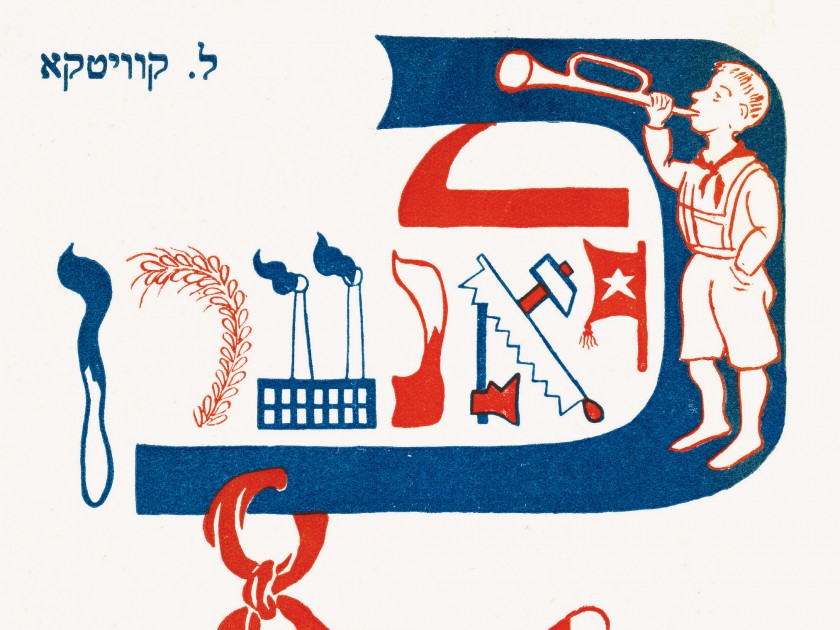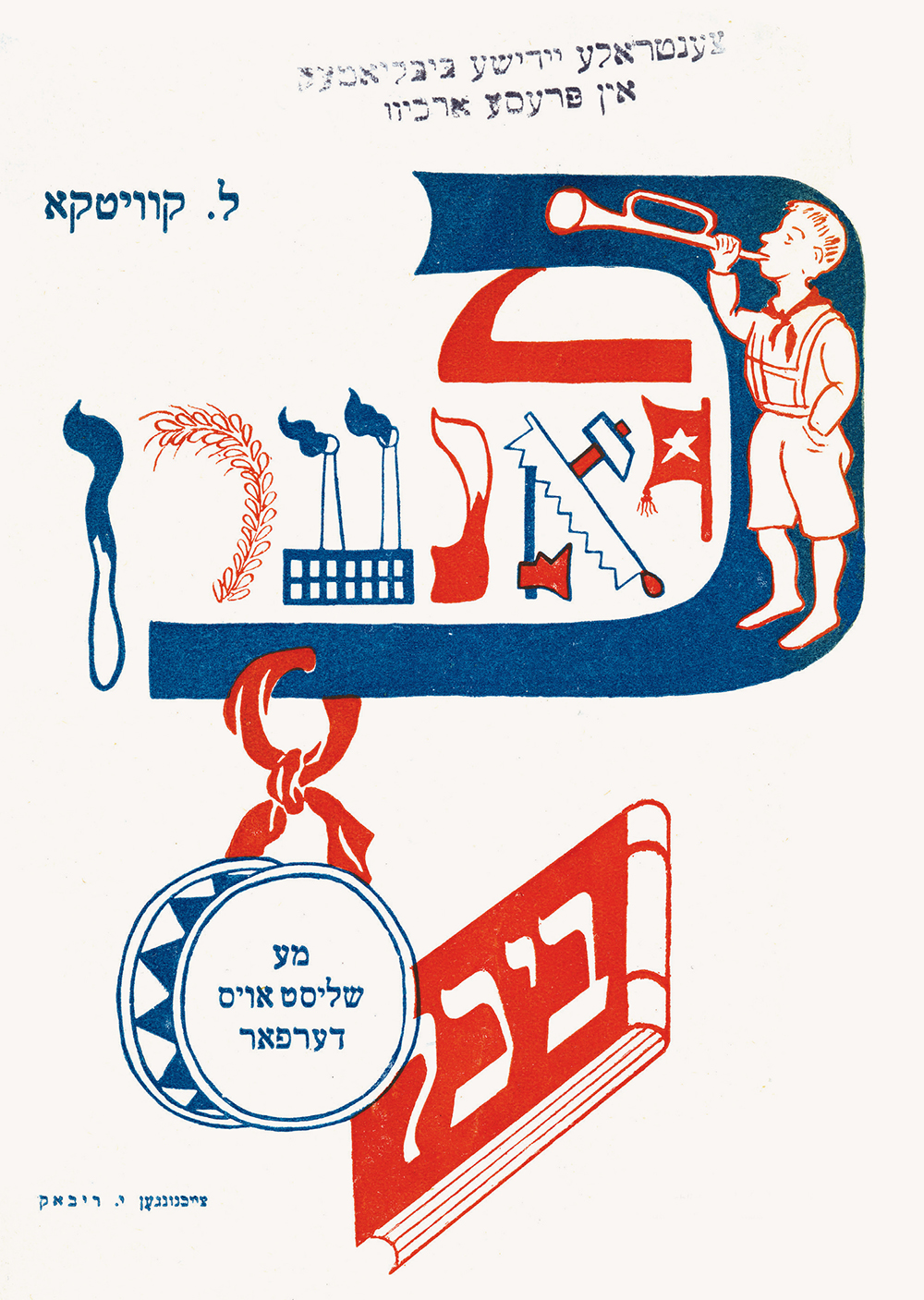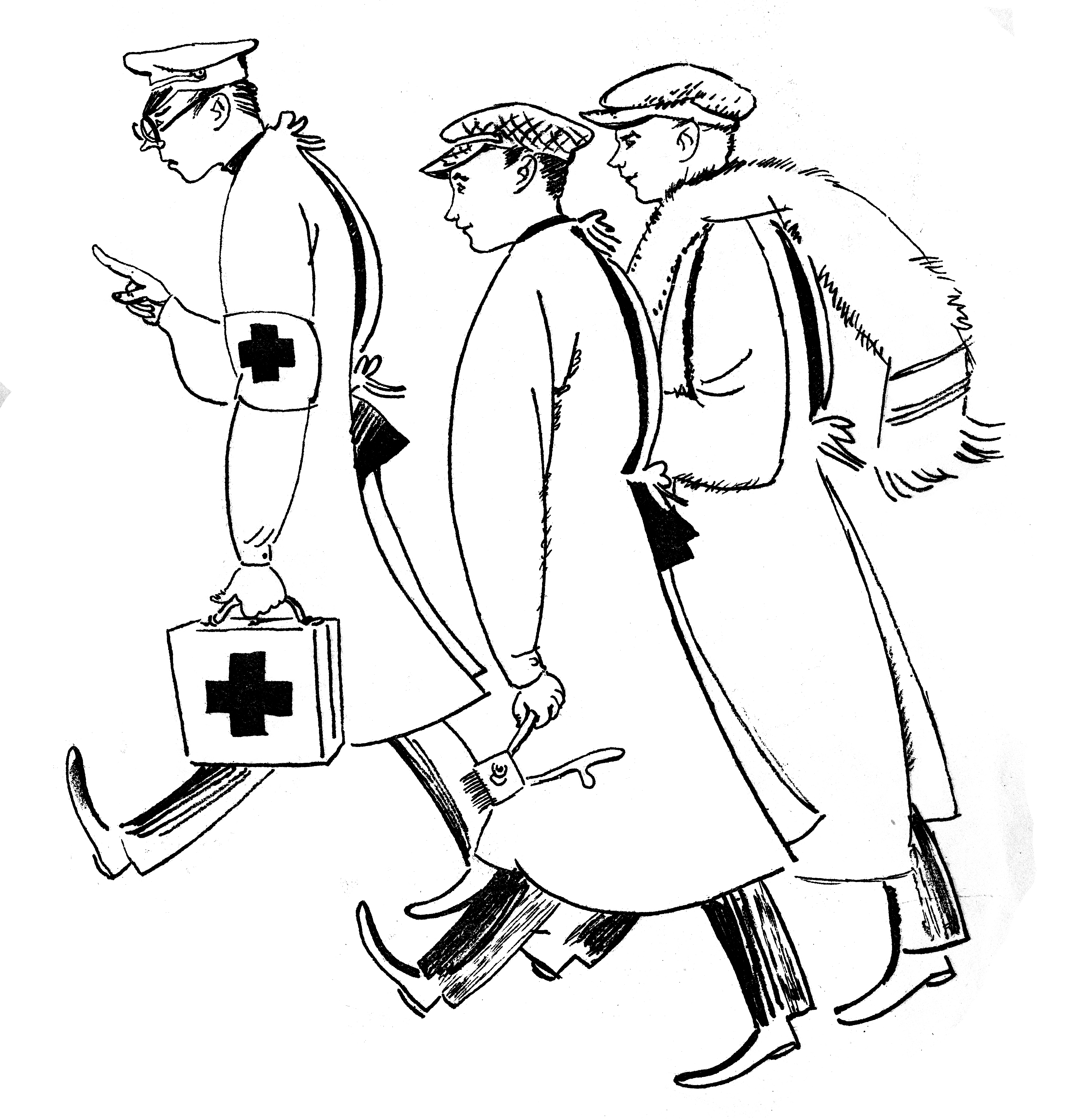
Today’s parents are accustomed to relying on children’s books to instill moral values; lessons such as the importance of caring for the vulnerable strike us as unobjectionable and universal. The idea of a children’s book with a political message, however, would register as unseemly with many contemporary readers. But this wasn’t always the case. In the 1920s and ’30s, children’s literature offered an especially hospitable arena for politically tendentious writing. Whereas an overtly ideological plotline or narrative voice might have been off-putting to adult readers — especially as this was during the height of literary modernism— simple, direct messages were considered beneficial to juvenile readers.
At this time, Yiddish cultural leaders emphasized education as a pathway to forming a new kind of Jew — secular, physically fit, roundly educated, and literate in Jewish culture — a Jew liberated from what they considered to be the superstitions and religious pieties of previous generations. Community organizations in Europe and New York allocated hefty resources to establishing an infrastructure of schools (in Poland and Russia), after schools (in the Americas), summer camps, and orphanages. These institutions were in turn furnished with books and periodicals published by presses dedicated to promoting particular ideologies. As Naomi Prawer Kadar explains in Raising Secular Jews: Yiddish Schools and their Periodicals for American Children, 1917 – 1950, socialists, communists, and Zionists each had publications for youth through which they sought to stake a claim on the Jewish future. Nowhere were political tendencies more prominent than in communist fiction for children, where the traditional centrality of the family was reassessed or subverted altogether.
Two popular authors of this period, Leyb Kvitko and Gershon Einbinder (whose pen name was Khaver Paver), can be seen as avatars of Soviet and American Yiddish communism, respectively. Kvitko worked in the Soviet Union; Khaver Paver emigrated to Los Angeles, where he became known for his stories about the precocious canine Labzik and the affable socialist family that adopts him. Both authors tended toward realism, in contrast to the romanticizing, folkloric predilections of much Yiddish children’s literature of the period. Both also frankly addressed political themes.
But in one key respect Kvitko and Khaver Paver neatly invert each other. The human and canine members of Khaver Paver’s exemplary and conventional father-motherboy-girl-dog family experience the world and absorb its lessons through the medium of family, with its hierarchical but cooperative gender and generational power dynamics. His stories cast the family as a microcosm of a cheerfully functioning, democratic country. (While the characters’ values and aims are communist, their methods are democratic; many communist countries also aspire or aspired to be fully realized democracies.) Kvitko, on the other hand — like many of his compatriots — sketches portraits of children with absent or incompetent parents. They must overcome this deficiency by falling back on their own internal resources as well as those of the Soviet state, the ultimate dispenser of care and guidance.
—
Leyb Kvitko was among the most popular Yiddish children’s authors in the Soviet Union. Born around 1890 near Odessa and orphaned in childhood, he was raised by his grandmother, as historian Gennady Estraikh recounts in the YIVO Encyclopedia. Despite — or perhaps because of — a working-class childhood, he harbored literary aspirations. In 1917, Kvitko arrived in Kiev wearing homespun garb, and was embraced as a folk talent. He published four collections of children’s poetry between 1917 and 1920, as well as modernist and folk poetry.
In the early 1920s, Kvitko spent time living in Germany, where he joined the communist party. In 1925, fearing that the German police would arrest him for his political activities, he fled back to Soviet Russia, where he was offered the editorship of a journal in Kharkov. His tenure there was rocky, thanks to internecine squabbling among Soviet Jewish literati; in 1929, he was removed from the masthead after publishing a satirical poem about a powerful Moscow editor.

Illustration by Y. Ribak from Me shlist oys derfar by Leyb Kvitko
As Estraikh chronicles in The Kharkiv Yiddish Literary World, 1920s – Mid-1930s, Kvitko was sent to work in a tractor factory for a couple of years. As the Russified Lev Kvitko, he was readmitted into official favor only after being championed by the leading Russian children’s writer, Kornei Chukovsky, whose support helped to ensure that his works in Russian and Ukrainian translation would enjoy print runs in the millions. Despite his eventual acclaim, Kvitko, along with other members of the Jewish Anti-Fascist Committee, was killed at Stalin’s behest on August 12, 1952 — the Night of the Murdered Poets.
The Stalin who ordered the death of Jewish poets, novelists, and activists would have been unrecognizable to the omniscient narrator of Kvitko’s 1940 picture book Vemes iz es meydele? (Whose Little Girl Is This?). In the hubbub of a busy train station, a mother mistakes another little girl for her own and leaves her daughter behind. At first, the abandoned girl is so paralyzed with fear that she can neither move nor speak, despite the best efforts of the passersby to identify and care for her. She grows increasingly upset, until, verging on tears, she spots a familiar face: “Ot iz do an eygener! / Ir alter guter-fraynt! / er hot azoy gor umgerikht / far ir ot do dershaynt!” (“Here was one of her own / A friend of many years / So very unexpectedly / Before her he appears!”). The onlookers follow her joyful gaze — to the portrait of Stalin hanging between two windows in the station, toward which the girl now makes her way. She has located a paternal presence to substitute for the missing maternal one. Reassured, she is ready to address the crowd, which she does with confidence and precocity, stating her name (Maya Volokova), age (three), and street address. The onlookers are charmed, and rush to aid and engage her in various ways. “Un dos meydele-se lakht, un dos meydele — se shaynt / lebn groysn kinder-fraynt.” (“The girl lit up with laughter, had nary a care / By the Great Friend of Children everywhere!”) Just at this happy climax, Maya’s mother comes back to claim her. Significantly, the predominant emotions in the story are fear and relief. Perhaps, through his sanguine portrayal, Kvitko sought to curry favor, or to assuage his readers’ latent fears of “Papa” Stalin’s wrathful real-life authoritarianism.
Sometimes Soviet Jewish parents in Kvitko’s books were most conspicuous through their complete absence; the vacated space is taken over by agents of the state. Buts un di sanitarn (Boots and the Bath Squad) details the appetite of a gluttonous boy who refuses to bathe. Boots’s Jewish identity is marked only by the fact that he lives in the shtetl. We hear about his unrestrained love of his favorite sweets, and then, onto the scene burst a detachment of three sanitarn, government sanitation agents who are tasked with forcibly bathing the recalcitrant youth. Their mandate stems from a combination of germ theory and a muted but unmistakable dirt libel against the Jews:
The Bathman
Sang out shrill as trumpet’s metal:
“A cold is going ’round the shtetl
What a punk!
What a craw!
Such filthy funk!
His dirty maw!
Grab that Boots, that grubby schlub!
Drag him over to the tub!
Turn on the taps!
No time to cosset,
Hurry, get him to that faucet!”
The shtetl locale encodes perceived Jewish proclivities for gluttony and filth, each believed to be unhealthy and unenlightened in its own counter-Soviet way. As Estraikh explains in his contribution to the essay collection Children and Yiddish Literature: From Early Modernity to Post-Modernity, the Soviet revolution abolished the official designation of the shtetl, or prominently Jewish town. Nevertheless, the locale endured in the popular imagination as a site of all that was “premodern and not really Soviet.” Kvitko walks a fine line between adopting Soviet ideology, even where it called on him to repudiate Jewish cultural touchstones, and making those Soviet requirements seem preposterous by dint of his exuberant verse.

The three sanitarn from Buts un di sanitarn by Leyb Kvitko, illustrated by Boris Fridkin
In the illustrations by Boris Fridkin, the henchmen of the bath squad are intimidating, preternaturally elongated figures. Boots’s forcible bathing is by turns traumatic and comical — his socks are so caked onto to his feet that they cannot be removed before the bath but must instead be left to float to the surface — but when it is finished, the boy comes to appreciate his new state of cleanliness.
When they took him from the bath,
He beamed with pride, began to laugh;
He didn’t recognize himself
Sitting on a chair so grand.
He reached to shake the Bathman’s hand.
With no parental interference, the state effects a transformation of the dirty shtetl-dweller so thorough as to render him unrecognizable to himself.
Now we pass from Soviet cleanliness to the more familiar squalor of the New York subway system in order to examine some of the Labzik stories by Khaver Paver. A native of Bershad, Bessarabia, the author emigrated to the United States in 1924, at the age of twenty-three. He worked as a teacher in the Yiddish schools and contributed regularly to the newspaper Di frayhayt. He lived in the bustling New York imprinted on his stories, and then moved to Los Angeles, where he wrote a few scripts for Hollywood while continuing to write for adults and children in Yiddish. Labzik, published in 1935, was distributed through the Yiddish shules of the International Workers Order, the most communist-aligned of the four secular Yiddish school systems functioning in New York — and the book’s proletarian sympathies are vividly clear.
When we meet Labzik, he is cowering on the platform of an elevated train station in the Bronx, where he has been abandoned by his well-meaning but impoverished owner. The creature’s whimpering attracts the attention of kindly Berl the (sewing machine) Operator, who decides to take a chance and delight his son Mulik and daughter Rifke with the gift of a dog.
The family inhabits a milieu thick with socialist and communist youth culture. The children attend public school each morning and then a secular Yiddish shule in the afternoon, where “The Internationale” is sung and various political causes are highlighted. They also maintain a Lenin-vinkl, a “Lenin corner” in their room, complete with a poster of their secular icon. One afternoon, brother and sister head to the intersection near the train station to collect funds for the benefit of Ernst Thälmann, the Weimar-era leader of the Communist Party of Germany, who was held in solitary confinement for eleven years before his execution at Buchenwald. A policeman tries to arrest Mulik, Rifke, and Labzik, but as he holds the kicking, struggling kids and dog by their collars, a sympathetic crowd of workers shouts their rebuke to the “paskudner kahp,” the lousy cop.
When Mulik organizes a children’s strike to demand meals for all the children, Labzik delivers contraband pamphlets. He is threatened with arrest until the children ring the animal control wagon and stage a sit-in, allowing the dog to escape. The children’s action is but a pale imitation of the adult political activity recounted in what is perhaps the book’s darkest chapter. Berl’s boss extends the workday to nine in the evening, prompting the workers to strike. But there are eight holdouts in the shop on 34th Street. Berl climbs up to the shop on the eighteenth floor, hoping to persuade the holdouts to join the strike. The bosses have him jumped by goons (identified in the text as gengsters), tied up, and thrown behind a locked door on the roof of the building. Labzik, who has snuck along for the adventure against the wishes of the family, sniffs out Berl and summons help. The strike prevails.
In addition to its pure charm value, having a canine protagonist allows Khaver Paver to capitalize on Labzik’s uncannily intuitive, near-human intelligence, and, at the same time, on his ultimately being “just a dog” — unenlightened, and sometimes literally inhuman. When Labzik bites Mulik’s black friend Noyekh on the leg, another friend accuses the dog of being a vayser shovinist (“white chauvinist,” a term for “racist” at the time). Mulik not only gives his pet ten lashes, but also convenes a trial before all the other kids from the block. They determine that Labzik must be ostracized for a full week for his crime. This punishment is so hard on the social animal that after a few days, as Khaver Paver informs the reader, he wishes he could drown in a river instead. When the week is up, Labzik has learned his lesson — he wouldn’t bite a black child who’d done nothing to him, even for a whole house full of lembchops—and the Yiddish-speaking children from the block have learned their lesson, too. Through Labzik, Khaver Paver could critique the darker, more animalistic side of human nature and encourage children to overcome it. Politically progressive, racially enlightened — these are the qualities that Khaver Paver foregrounds as both Jewish and American, seamlessly joined. And the place where those values are modeled and discussed is the home of the Jewish worker.
In his books, Kvitko needed parents out of the way so that the state could be shown to nurture its youngest citizens directly. In story after story, the nuclear family is temporarily compromised or permanently dismantled to create space for a nationalized parental presence; “Papa” Stalin figures as the only father who can give effective care, and thus the only parent who ultimately matters. The loss or vitiation of parents goes unremarked or is even celebrated rather than mourned. In contrasting American fashion, Berl and Molly’s functional, involved family provides the fertile soil where their children’s political identity is cultivated: brother and sister learn by imitating their parents’ politics. The family’s sympathies and habits are bound up in their Jewishness, their yiddishkeyt, but not constrained by it. Communism is just as much their religion as Judaism — and, like a traditional religion, the gentler American version of this political faith guides them to seek justice and pursue ways of kindness. The family overcomes any internal dissension to present a united front to the world — unambivalent in their stance against racism and poverty, resolute in their disdain for the bourgeoisie. While the Labzik stories focus tightly on the portrait of a single family, it is meant to be a broadly representative one — with all members acting, as a nation might, on high-minded commitments and robust democratic norms for the betterment of humanity.
Images from the library of the YIVO Institute for Jewish Research, New York
Miriam Udel is associate professor of Yiddish language, literature, and culture and the Judith London Evans Director of the Tam Institute for Jewish Studies at Emory University. She is the author of Never Better! The Modern Jewish Picaresque and the editor and translator of Honey on the Page: A Treasury of Yiddish Children’s Literature.